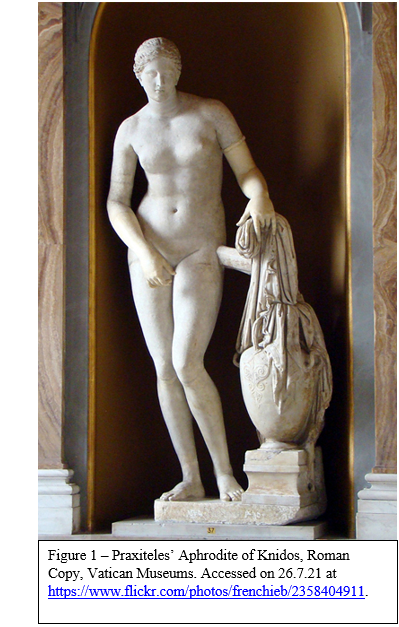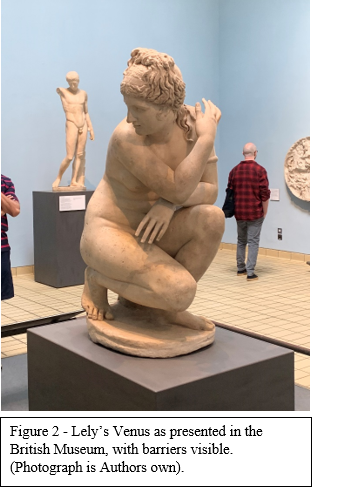Freeing Venus: Is the nude Aphrodite of Knidos statue liberating or does it facilitate inappropriate behaviour from the viewer? - Louisa Armitage
The Aphrodite of Knidos statue and its treatment in both the modern day and ancient times highlights issues of sexualisation, objectification and consent. Of course, women still face these issues today, nearly two and a half millennia after the statue’s creation. This statue is therefore a useful object from which to explore the mistreatment of women through different societies, ancient and modern.
 The statue dates to the 4th century BC and was created by the Greek sculptor Praxiteles. It presents the Goddess Aphrodite naked but slightly covering herself, as if the viewer has just walked in on her bathing. Although the original statue no longer exists, many copies remain, from which we can develop an idea of what the original looked like. One of the best-preserved copies is that currently displayed in the Vatican (Figure 1). In addition to its aesthetic qualities, the statue raises important questions about the sexualisation and mistreatment of women in both the ancient and modern worlds.
The statue dates to the 4th century BC and was created by the Greek sculptor Praxiteles. It presents the Goddess Aphrodite naked but slightly covering herself, as if the viewer has just walked in on her bathing. Although the original statue no longer exists, many copies remain, from which we can develop an idea of what the original looked like. One of the best-preserved copies is that currently displayed in the Vatican (Figure 1). In addition to its aesthetic qualities, the statue raises important questions about the sexualisation and mistreatment of women in both the ancient and modern worlds.
The ancient Greeks believed that seeing a goddess bathing could lead to blindness and even death (Euripides Callimachus Bath of Pallas 68-83). If this is what they believed, then why did Praxiteles create this statue, and why was it popular enough to have so many copies made even hundreds of years after its original creation? It has been argued that the ancient viewers must have thought that Aphrodite “was complicit and happy to be looked at” (Vout 2013 pg188) in this way in order for them to justify viewing this statue. This idea highlights two interesting points of discussion. Firstly, it indicates the different ideas one can gain about a statue based upon the angle it is viewed from and how it is displayed. If the viewer makes direct eye contact with the statue (as in Figure 1), Aphrodite seems as if she is about to punish them. But if one looks at the statue from the side, they seem to get a sultry invitation from the Goddess. It is likely that this scholarly idea was formed from the second way of viewing because it is only this angle which gives the idea that Aphrodite is complicit with being seen while bathing.
The second discussion point focuses on consent. By claiming that Aphrodite’s nakedness and lack of attempt to cover herself indicates she is complicit in being viewed and inviting such gazes, the viewer can justify whatever feelings of sexual desire they may experience when looking at this statue. An extreme reaction is described by both Pliny the Elder (Natural History 36.21) and Lucian (Amores 13-14), with a young man becoming so enthralled by the beauty of the statue that he left a semen stain on her thigh.
This debate about a woman’s modesty and consent is still ongoing, even in the modern day. The Slutwalk movement, which began in 2011, is a response to issues surrounding violence to women, many of which are highlighted by the #MeToo movement and, more recently, by the protests kickstarted in response to the murder of Sarah Everard and, sadly, those that followed further murders. These ‘Slutwalks’ focus on the fact that just because a woman is dressed ‘immodestly’, it does not mean that she consents to verbal and physical abuse, usually of a sexual nature, that many women are subjected to. The issues that movements such as this focus on are significant in telling the story of the Aphrodite of Knidos statue because they add a whole new layer to what the viewer may perceive when studying it. When one reads stories such as that in Lucian’s Amores while learning about this object, it is natural that they will question this action in relation to more modern ideas surrounding the treatment of women.

This is not to say, however, that statues, especially ones of Venus, are not still treated in an inappropriate, sexual nature. The crouching Aphrodite statue, or ‘Lely’s Venus’ (Figure 2), is currently displayed in the British Museum behind barriers, in stark contrast to other statues in the gallery, due to the inappropriate touch the statue was frequently receiving. This further highlights that, while the lack of clothing on statues of Aphrodite may be considered ‘freeing’ for women in ancient Greece, as most of the statues of women were clothed, these statues still received, and continue to receive, treatment that trapped them in the place of most women in ancient society. A place where they were perceived as less than men, and as objects to be viewed in a sexualised manner by the men of that society. This is especially important when one considers that it was viewed as wrong for goddesses such as Aphrodite to be the subject of mortal men’s desires. It seems that viewers of statues such as this went to many lengths to justify their thoughts and actions instead of admitting that their actions may have been wrong.
In conclusion, while one may argue that this statue is unique in portraying, in the simplest of terms, a naked woman, one cannot argue that this is fully liberating to ancient women. The nudity that this statue presents led to a whole new level of sexualisation which other statues of women were not subjected to in the same extremity. Subsequently, to modern viewers, this statue signifies more than just the beauty of women’s bodies. It signifies the sexualised way that women were treated in the ancient world and continue to be treated in our contemporary society.
Bibliography
Primary Sources
Lucian, Amores, trans. M. D. Macleod (Cambridge, Mass.: Harvard University Press 1967).
Pliny the Elder, Natural History, trans. D. E. Eichholz (Cambridge, Mass.: Harvard University Press 1962).
Secondary Sources
Candlin, F. (2017) ‘Rehabilitating unauthorised touch or why museum visitors touch the exhibits’, The Senses and Society 12:3.
Jenkins, I. (2015) Defining beauty: the body in ancient Greek art (London: British Museum).
Vout, C. (2013) Sex on show: seeing the erotic in Greece and Rome (London: British Museum).
Internet Sources
Evans, P. Amber Rose’s Slutwalk: is the controversial feminist movement still relevant? https://www.newstatesman.com/politics/feminism/2017/09/amber-roses-slutwalk-controversial-feminist-movement-still-relevant. Accessed 28th July 2021.
Table of Figures
Figure 1 – Praxiteles’ Aphrodite of Knidos, Roman Copy, Vatican Museums. Accessed on 26.7.21 at https://www.flickr.com/photos/frenchieb/2358404911.
Figure 2 - Lely’s Venus as presented in the British Museum, with barriers visible. (Photograph is Authors own).
